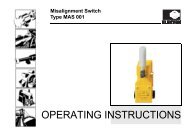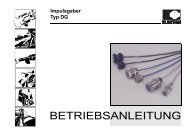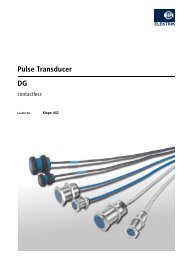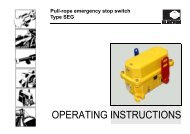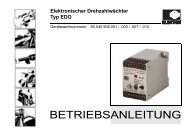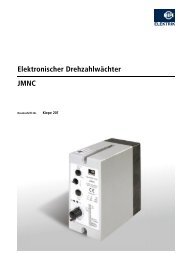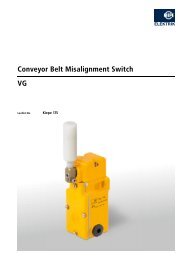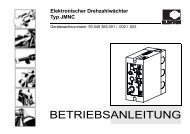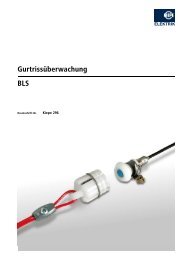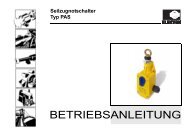OPERATING INSTRUCTIONS - Kiepe Elektrik
OPERATING INSTRUCTIONS - Kiepe Elektrik
OPERATING INSTRUCTIONS - Kiepe Elektrik
You also want an ePaper? Increase the reach of your titles
YUMPU automatically turns print PDFs into web optimized ePapers that Google loves.
Roller lever limit switches<br />
Type HER and REL<br />
<strong>OPERATING</strong> <strong>INSTRUCTIONS</strong>
Legal Notice<br />
Operating instructions (Translation of original)<br />
Document No.: 94.062 556.191<br />
Roller lever limit switches, Type HER and REL<br />
Equipment identification no.: various<br />
Date of Issue: 02.09.2009<br />
Update Status: Index B<br />
CE conformity certificate<br />
The device complies with the relevant European and<br />
national regulations.<br />
CE conformity has been certified; the relevant records<br />
and documents are in the hands of the manufacturer.<br />
Protective note (as per DIN ISO 16016:2002-5)<br />
Forwarding and duplicating this document, as well as<br />
using or revealing its contents are prohibited without<br />
written approval. Noncompliance is subject to<br />
compensatory damages. All rights reserved with regard<br />
to patent claims or submission of design or utility patent.<br />
www.kiepe-elektrik.com Vossloh <strong>Kiepe</strong> GmbH Tel.: +49(0)211/7497–0<br />
<strong>Kiepe</strong>-Platz 1<br />
D–40599 Düsseldorf<br />
Germany<br />
Fax: +49(0)211/7497–420<br />
CONFIDENTIAL
CONFIDENTIAL<br />
Table of contents<br />
Table of contents<br />
1 For your safety..................................................................................................................5<br />
1.1 Intended use .................................................................................................................................................5<br />
1.2 Design of warnings .......................................................................................................................................5<br />
2 Transport, storage and disposal .......................................................................................7<br />
2.1 Transport and packaging ..............................................................................................................................7<br />
2.2 Storage .........................................................................................................................................................7<br />
2.3 Disposal ........................................................................................................................................................7<br />
3 Description........................................................................................................................8<br />
4 Technical data ..................................................................................................................9<br />
4.1 General technical data..................................................................................................................................9<br />
4.2 Device identification....................................................................................................................................10<br />
4.3 Device variants ...........................................................................................................................................11<br />
4.4 Dimensions .................................................................................................................................................12<br />
Operating instructions HER and REL<br />
3
4<br />
Table of contents<br />
5 Mounting and dismounting .............................................................................................14<br />
5.1 Scope of delivery........................................................................................................................................ 14<br />
5.2 Mounting .................................................................................................................................................... 15<br />
5.2.1 Mechanical mounting ................................................................................................................................. 15<br />
5.2.2 Electrical connection .................................................................................................................................. 17<br />
5.2.3 Adjusting the switch points......................................................................................................................... 19<br />
5.2.4 Commissioning........................................................................................................................................... 22<br />
5.3 Dismounting ............................................................................................................................................... 23<br />
6 Maintenance...................................................................................................................24<br />
7 Repairs...........................................................................................................................25<br />
7.1 Replacing the roller lever ........................................................................................................................... 25<br />
8 Ordering devices, replacement parts and accessories ..................................................26<br />
8.1 Ordering devices........................................................................................................................................ 26<br />
8.2 Ordering replacement parts and accessories ............................................................................................ 27<br />
HER and REL Operating instructions<br />
CONFIDENTIAL
CONFIDENTIAL<br />
1 For your safety<br />
1.1 Intended use<br />
The roller lever limit switches of type HER and REL are<br />
used to limit the travel of movable machine parts and to<br />
limit travel paths. The roller lever limit switches HER and<br />
REL are suitable for use in transport, conveyance, loading,<br />
and mixed systems for bulk materials. The device is<br />
intended for use in stationary installations and vehicles.<br />
The documentation at hand is to be considered part of<br />
the product and must be retained and be available to the<br />
respective owner/user for the entire service life of the<br />
product. The documentation must be passed on to each<br />
subsequent owner of the product.<br />
The manufacturer is not liable for personal injury and<br />
property damage arising from non-intended use of the<br />
device or unauthorized modifications to the device and<br />
its components. Make sure that the intended use is not<br />
impaired in any way even after unexpected outside<br />
influence on the device.<br />
Intended use refers specifically to the operation of the<br />
device in accordance with these operating instructions.<br />
Work on this device may only be carried out by<br />
qualified personnel who are familiar with accident<br />
prevention regulations as well as other generally<br />
recognized safety regulations.<br />
1 For your safety<br />
By using the equipment as intended, you protect<br />
yourself and prevent damage to the equipment and<br />
its components.<br />
1.2 Design of warnings<br />
Risks are classified in accordance with ISO 3864-2 and<br />
ANSI Z535.6 using the keywords<br />
• “Danger,” “Warning,” and “Caution” in the case of<br />
bodily injury,<br />
• “Beware” in the case of property damage, and<br />
• “Note” to convey general information.<br />
In this documentation, the Risks and Notes are classified<br />
and presented as follows:<br />
Operating instructions HER and REL<br />
!<br />
Danger!<br />
indicates the immediate threat of danger. Not avoiding<br />
this danger will result in death or extremely serious injury<br />
(crippling).<br />
5
6<br />
!<br />
1 For your safety<br />
Warning!<br />
indicates a possibly dangerous situation. Not avoiding<br />
this dangerous situation could result in death or<br />
extremely serious injury (crippling).<br />
!<br />
Caution!<br />
indicates a possibly dangerous situation. Failure to<br />
avoid this dangerous situation can result in light or<br />
minor injuries.<br />
!<br />
Beware!<br />
indicates a possibly harmful situation. If this harmful<br />
situation is not avoided, the product or something in its<br />
vicinity could be damaged.<br />
Note!<br />
“Note” indicates advice on use and other especially<br />
helpful information.<br />
Icons<br />
The following icons are used to more clearly define the<br />
sources of danger. The icons can appear in reference to<br />
any level of danger.<br />
Icon Type of danger<br />
Dangers of all types, except those that are<br />
labeled with the following icon<br />
Injuries caused by dangerous voltages and<br />
currents.<br />
Damage caused by electrostatic<br />
discharges (ESD protection)<br />
Table 1-1: Icons for general sources of danger<br />
HER and REL Operating instructions<br />
CONFIDENTIAL
CONFIDENTIAL<br />
2 Transport, storage and disposal<br />
2.1 Transport and packaging<br />
Select suitable packaging when sending the device or<br />
components of the device to Vossloh <strong>Kiepe</strong> GmbH,<br />
e.g. for repairs. In particular, ensure that the components<br />
are kept clean and protected from shock and moisture.<br />
This prevents damage to the components that may occur<br />
during transport, for which the manufacturer accepts no<br />
liability.<br />
2.2 Storage<br />
Avoid major temperature fluctuations, as these can lead<br />
to condensation that can cause damage to the device<br />
and its components.<br />
Permissible storage temperature: see Chapter 4: “Technical<br />
data”, page 9<br />
2 Transport, storage and disposal<br />
Operating instructions HER and REL<br />
!<br />
Damage caused by storage<br />
Dirt or water getting into the device and exposure to<br />
weather (e.g. buildup of condensation in the device,<br />
sunlight) damage the device and lead to faster deterioration.<br />
Protect the device by storing it in a clean, dry place<br />
under stable ambient conditions. If possible, store the<br />
device in its original packaging.<br />
2.3 Disposal<br />
Only materials that are not considered hazardous<br />
according to current engineering practice are used for<br />
Vossloh <strong>Kiepe</strong> GmbH products. Furthermore, we develop<br />
products that can be recycled after their period of intended<br />
use. In our selection of raw materials and components,<br />
we favor reusable materials. This choice of<br />
materials does not compromise product safety in any<br />
way.<br />
7
8<br />
3 Description<br />
3 Description<br />
Roller lever limit switches of the type HER and REL are<br />
used to limit the paths of machine parts for example in<br />
loading, mixed, and transport systems for bulk materials.<br />
Systems can be switched off promptly by the roller lever<br />
limit switch to prevent operational malfunctions.<br />
For example, roller lever limit switches of type HER and<br />
REL can be mounted on the ends of transport systems.<br />
Devices on the transport trolleys actuate the roller lever<br />
limit switches when the end of the transport path has<br />
3<br />
2<br />
1<br />
Roller lever (3)<br />
Transport trolley<br />
Fig. 3-1: Roller lever limit switch of type HER - mounting example<br />
been reached. The system is switched off and the transport<br />
trolley stopped (see fig. 3-1).<br />
The roller lever (3) can be moved in two directions. Depending<br />
on the device, the switch points are at a deflection<br />
of 5° (1) and 35° (2). Both switch points can be used<br />
to switch off the system (see section 5.2.3: “Adjusting the<br />
switch points”, page 19).<br />
HER and REL Operating instructions<br />
1<br />
2<br />
3<br />
CONFIDENTIAL
CONFIDENTIAL<br />
4 Technical data<br />
4.1 General technical data<br />
In compliance with the following<br />
standards and regulations<br />
EN 60947-5-1<br />
VDE 0110 – Pollution degree 2 (inside), 4 (outside)<br />
4 Technical data<br />
Suitable for Controls and installations according to EN 60204<br />
Casing HER: Aluminum, REL: Gray cast iron<br />
Mounting HES: two slotted holes for M 8 screws<br />
SEL: two slotted holes for M 10 screws<br />
Permissible ambient temperature -25°C to +70°C<br />
Permissible storage temperature - 25 °C to + 70 °C<br />
Max. altitude above sea level 2.000 m (contact manufacturer for installation on sites at higher altitudes)<br />
Protection standard IP 67, IP 67 per EN 60529<br />
Switching system Snap-acting switch, max. four positive-opening change-over contacts<br />
Switch points Adjustable: 5° to 15° and 15° to 35°<br />
Default setting: 2 x 10°<br />
Deflection of the roller lever Max. 75°<br />
Rated insulation voltage Ui AC 380 V, DC 250 V<br />
Conventional thermal current Ith 6A<br />
Breaking capacity AC-15: Ue = AC 230 V, Ie = 1.5 A<br />
DC24V, t = 2ms to 3ms, to 3A<br />
Conductor infeed Tapped hole for 2 x M25 x 1.5<br />
1 x screwed cable gland M25 x 1.5; sealing area Ø 11 mm to Ø 16 mm<br />
1 x dummy plug M25 x 1.5<br />
Operating instructions HER and REL<br />
9
10<br />
4 Technical data<br />
Line connection cross-section 0,75 mm2 to 1.5 mm2 Protective conductor connection In the casing, M4, protective conductor cross-section max. 2.5 mm<br />
Weight HER: approx. 1900 g<br />
REL: approx. 5500 g<br />
4.2 Device identification<br />
The devices are marked with a device identification number<br />
consisting of an 8-digit basic number and a 3-digit<br />
variant number:<br />
Fig. 4-1: Printed impression<br />
Type identification<br />
Product number: Basic<br />
number and variant<br />
number<br />
Type Basic number Variant number<br />
HER 92.064544.6xx see section 4.3, page 11<br />
REL 92.056979.6xx see section 4.3, page 11<br />
You will find the exact type and variant number on the rating<br />
plate on the exterior of the casing.<br />
HER and REL Operating instructions<br />
CONFIDENTIAL
CONFIDENTIAL<br />
4.3 Device variants 1<br />
Variant number Type Technical data (see section 4.1)<br />
4 Technical data<br />
60x Basic device without/with signal lamp –<br />
61x Basic device with DUPLINE module See also the "DUPLINE module for roller lever limit<br />
switches" operating instructions:<br />
HER 21x: 94.063911.191<br />
REL 21x: 94.063912.191<br />
1. Deviations are possible for certain types.<br />
Operating instructions HER and REL<br />
11
12<br />
4 Technical data<br />
4.4 Dimensions<br />
8,5<br />
Fig. 4-2: HER dimensions<br />
54<br />
95 + 5<br />
162<br />
176<br />
111<br />
M 25 x 1,5<br />
M 25 x 1,5<br />
HER and REL Operating instructions<br />
7<br />
179<br />
CONFIDENTIAL
CONFIDENTIAL<br />
205<br />
36<br />
Fig. 4-3: REL dimensions<br />
~ 160<br />
70<br />
11<br />
4 Technical data<br />
Operating instructions HER and REL<br />
12<br />
177<br />
124<br />
186<br />
ø 50<br />
13
14<br />
5 Mounting and dismounting<br />
5 Mounting and dismounting<br />
5.1 Scope of delivery<br />
The roller lever limit switches are supplied ready for operation.<br />
The screws for mechanical fastening are not included<br />
in the scope of delivery.<br />
One screwed cable gland (6) and one dummy plug (25)<br />
are included in the scope of delivery (see fig. 5-1).<br />
Screwed cable<br />
gland (6)<br />
Dummy plug (25)<br />
Fig. 5-1: Roller lever limit switches - scope of delivery<br />
HER and REL Operating instructions<br />
!<br />
Beware!<br />
The device must only be operated when all three holes<br />
are closed with the supplied cable gland (6) and the<br />
dummy plug (25). Only use the supplied screwed cable<br />
gland (6) and dummy plug (25), otherwise the seal can<br />
no longer be guaranteed.<br />
CONFIDENTIAL
CONFIDENTIAL<br />
5.2 Mounting 5.2.1 Mechanical mounting<br />
Danger of fatal electric shock<br />
Work on the device may be performed only by a qualified<br />
electrical technician.<br />
Prior to working, switch off the power supply to the system.<br />
Ensure that the system cannot be accidentally<br />
switched on. Mask any neighboring components that<br />
may be live to prevent contact.<br />
!<br />
Beware!<br />
The roller lever limit switches are to be used in control<br />
circuits only.<br />
!<br />
Beware!<br />
The device must only be operated when all three holes<br />
are closed with the supplied cable gland (6) and the<br />
dummy plug (25). Only use the supplied screwed cable<br />
gland (6) and dummy plug (25), otherwise the seal can<br />
no longer be guaranteed.<br />
5 Mounting and dismounting<br />
Operating instructions HER and REL<br />
!<br />
Beware!<br />
15<br />
Roller lever limit switches should limit the paths of machine<br />
parts. Mount the roller lever limit switch on the<br />
system so that the roller lever limit switch always<br />
switches to safe position when the machine part reaches<br />
its end point.<br />
The installation location of the roller lever limit switches<br />
depends on the type of system and how the roller lever<br />
limit switch is used. Mount the roller lever limit switch on<br />
Transport trolley<br />
Fig. 5-2: Mounting example<br />
Roller lever (3)
16<br />
5 Mounting and dismounting<br />
the system so that the roller lever limit switch always<br />
switches to safe position when the machine part reaches<br />
its end point (see fig. 5-2).<br />
1. Prior to working, switch off the power supply to the<br />
system. Ensure that the conveyor system cannot be<br />
accidentally switched on. Mask any neighboring<br />
components that may be live to prevent contact.<br />
2. Fasten the roller lever limit switch on the system<br />
(see section 4.4: “Dimensions”, page 12). Secure<br />
the roller lever limit switch by screwing two screws<br />
through the slotted holes (10) (see fig. 5-3).<br />
3. Fit the roller lever (3) onto the shaft (14).<br />
Slotted hole (10)<br />
Slotted hole (10)<br />
Fig. 5-3: Mounting the roller lever limit switch on the system<br />
4. Set the roller lever (3) to the required position and<br />
retighten the nut (9).<br />
Fig. 5-4: Mounting the roller lever<br />
Roller lever (3)<br />
Shaft (14)<br />
Nut (9)<br />
HER and REL Operating instructions<br />
CONFIDENTIAL
CONFIDENTIAL<br />
5 Mounting and dismounting<br />
5.2.2 Electrical connection 1. Prior to working, switch off the power supply to the<br />
system. Ensure that the conveyor system cannot be<br />
Danger of fatal electric shock<br />
Work on the device may be performed only by a qualified<br />
electrical technician.<br />
Prior to working, switch off the power supply to the system.<br />
Ensure that the system cannot be accidentally<br />
switched on. Mask any neighboring components that<br />
may be live to prevent contact.<br />
!<br />
Danger!<br />
Only use connection cables with a diameter of at least<br />
11 mm up to a maximum of 16 mm. The permissible<br />
conductor cross-sections are found in Chapter 4:<br />
“Technical data”, page 9.<br />
Penetration of dirt and water when gaskets<br />
! are damaged<br />
If gaskets are damaged, dirt and water can penetrate<br />
into the device and damage the device and its components.<br />
Check gaskets for damage before assembling. If the<br />
gasket is damaged, exchange the device cover.<br />
Operating instructions HER and REL<br />
17<br />
accidentally switched on. Mask any neighboring<br />
components that may be live to prevent contact.<br />
2. Open the cover (2) of the roller lever limit switch by<br />
loosening the two screws (5).<br />
3. Loosen the nut on the screwed cable gland (6) and<br />
thread the connection cable (Ø 11 mm to Ø 16 mm)<br />
through it (see fig. 5-5).<br />
Cover (2)<br />
Gasket (22)<br />
Casing (1)<br />
Switch (7)<br />
Fig. 5-5: Connections<br />
Cam disc (11)<br />
Protective conductor<br />
connection (8)<br />
Screwed cable gland (6) Dummy plug (25)
18<br />
5 Mounting and dismounting<br />
4. Connect the connection cable to the terminals of the<br />
switch (7) in the cover (2) of the roller lever limit<br />
switch according to the connection diagram (see<br />
fig. 5-6).<br />
5. Attach the protective conductor (max. 2.5 mm 2 ) to<br />
protective conductor connection M4 (8) (conductor<br />
cross-sectional area depending on supply line, subject<br />
to a maximum of 2.5 mm 2 ).<br />
The factory setting for the switch points of the roller lever<br />
limit switches is 10° in both directions. The switch points<br />
of the roller lever limit switches can be adjusted as required.<br />
Rollenseite<br />
Position of Roller<br />
Fig. 5-6: Connection diagram for two change-over contact in<br />
the cover of the roller lever limit switch<br />
6. Adjust the switch point of the roller lever (3) on the<br />
cam disc (11), if a different switch point is required<br />
(see section 5.2.3: “Adjusting the switch points”,<br />
page 19).<br />
7. Tighten the nuts of the screwed cable gland (6) with<br />
a tightening torque of 6.7 Nm.<br />
Cover (2)<br />
Gasket (22)<br />
Casing (1)<br />
Switch (7)<br />
Fig. 5-7: Connections<br />
Cam disc (11)<br />
Protective conductor<br />
connection (8)<br />
Screwed cable gland (6) Dummy plug (25)<br />
HER and REL Operating instructions<br />
CONFIDENTIAL
CONFIDENTIAL<br />
!<br />
Beware!<br />
A device with a damaged gasket (22) must not be used.<br />
Remove any dust that may have entered the casing (1).<br />
8. Check the gasket (22) of the cover (2) for damage.<br />
9. Close the cover (2) of the roller lever limit switch.<br />
10. Secure the cover (2) with the screws (5).<br />
Tighten the screws (5) evenly to a tightening<br />
torque of 1.5 Nm.<br />
Screw (5)<br />
Dummy plug (25)<br />
Cover (2)<br />
Screwed cable gland (6)<br />
Screw (5)<br />
Fig. 5-8: Mounting the roller lever limit switch on the system<br />
5 Mounting and dismounting<br />
Operating instructions HER and REL<br />
19<br />
11. Put the roller lever limit switches into operation (see<br />
section 5.2.4: “Commissioning”, page 22).<br />
5.2.3 Adjusting the switch points<br />
The factory setting for the switch points of the roller lever<br />
limit switches is 10° in both directions. The switch points<br />
can be adjusted as required.<br />
3<br />
2<br />
0: Basic position<br />
1: Switch point at a deflection of 5° to 15°<br />
2: Switch point at a deflection of 15° to 35°<br />
3: Maximum deflection at 75°<br />
Fig. 5-9: Setting the roller lever limit switch points<br />
1<br />
0<br />
1<br />
2<br />
3
20<br />
5 Mounting and dismounting<br />
Danger of fatal electric shock<br />
Work on the device may be performed only by a qualified<br />
electrical technician.<br />
Prior to working, switch off the power supply to the system.<br />
Ensure that the system cannot be accidentally<br />
switched on. Mask any neighboring components that<br />
may be live to prevent contact.<br />
1. Prior to working, switch off the power supply to the<br />
system. Ensure that the conveyor system cannot be<br />
accidentally switched on. Mask any neighboring<br />
components that may be live to prevent contact.<br />
2. If necessary, open the cover (2) of the roller lever<br />
limit switch by loosening the two screws (5) (see<br />
fig. 5-8).<br />
Note<br />
There are two screws (15) in each of the two<br />
cams (11) (see figure 5-10, page 20). With one<br />
screw (15), the cam (11) is fixed in its basic setting.<br />
The second screw (15) is screwed into the<br />
cam (11).<br />
To adjust the cam (11), the first screw (15) is<br />
loosened just enough that the cam (11) can be<br />
turned. The screw (15) can remain in the de-<br />
vice. After being adjusted, the cam (11) is fixed<br />
with the second screw (15).<br />
Especially with small changes in the setting, this<br />
prevents the cam (11) from being turned back to<br />
its original position when the screw (15) is tightened.<br />
3. Adjust the switch point 1 (advance warning) (see<br />
figures 5-9 and 5-11).<br />
Adjustment range: 5° to 15°<br />
a. Loosen the screw (15) in the cam (11) enough<br />
that you can turn the cam (11).<br />
Cam discs (11)<br />
Screws (15)<br />
Roller lever (3)<br />
Fig. 5-10: Adjusting the switch points – Loosening screws in<br />
the cam disc<br />
HER and REL Operating instructions<br />
CONFIDENTIAL
CONFIDENTIAL<br />
b. Adjust the switch point 1 (advance warning) by<br />
turning the cam (11).<br />
c. Tighten the second screw (15) so that the cam<br />
(11) is fixed in the newly set position.<br />
4. Adjust the switch point 2 (switch off) .<br />
Adjustment range: 15° to 35°<br />
a. Pry the cam (11) out of the cam disc (12) to<br />
obtain a larger adjustment range.<br />
b. Loosen the screw (15) in the cam (11) enough<br />
that you can turn the cam (11).<br />
Cover (2)<br />
Gasket (22)<br />
Casing (1)<br />
Switch (7)<br />
Screwed cable gland (6)<br />
Cam disc (11)<br />
Cam (12)<br />
Dummy plug (25)<br />
Fig. 5-11: Adjusting the switching points – Prying out the cam<br />
5 Mounting and dismounting<br />
Operating instructions HER and REL<br />
21<br />
c. Adjust the switch point 2 (switch off) by turning<br />
the cam (11).<br />
d. Tighten the second screw (15) so that the cam<br />
(11) is fixed in the newly set position.<br />
5. Check the set switch points (see figure 5-9, page<br />
19).<br />
!<br />
Beware!<br />
A device with a damaged gasket (22) must not be used.<br />
Remove any dust that may have entered the casing (1).<br />
6. Check the gasket (22) of the cover (2) for damage.<br />
7. Close the cover (2) of the roller lever limit switch.<br />
8. Secure the cover (2) with the screws (5) (see<br />
figure 5-12, page 22).<br />
Tighten the screws (5) evenly with a tightening<br />
torque of 1.5 Nm.<br />
9. Put the roller lever limit switches into operation (see<br />
section 5.2.4: “Commissioning”, page 22).
22<br />
5 Mounting and dismounting<br />
5.2.4 Commissioning<br />
1. Before putting the roller lever limit switch into operation,<br />
ensure that it is sealed:<br />
– Ensure that the screws (5) on the cover (2) are<br />
tightened with a tightening torque of 1.5 Nm.<br />
– Check that the screwed cable gland (6) is<br />
tightened with a tightening torque of 6.7 Nm.<br />
– Check that the dummy plug (25) is fastened<br />
tightly.<br />
2. Check the entire belt misalignment switch and its<br />
components for damage.<br />
Screw (5)<br />
Dummy plug (25)<br />
Cover (2)<br />
Screwed cable gland (6)<br />
Screw (5)<br />
Fig. 5-12: Mounting the roller lever limit switch on the system<br />
HER and REL Operating instructions<br />
!<br />
Danger!<br />
Damaged roller lever limit switches must always be replaced.<br />
CONFIDENTIAL
CONFIDENTIAL<br />
5.3 Dismounting<br />
Danger of fatal electric shock<br />
Work on the device may be performed only by a qualified<br />
electrical technician.<br />
Prior to working, switch off the power supply to the system.<br />
Ensure that the system cannot be accidentally<br />
switched on. Mask any neighboring components that<br />
may be live to prevent contact.<br />
Cover (2)<br />
Gasket (22)<br />
Casing (1)<br />
Switch (7)<br />
Cam disc (11)<br />
Protective conductor<br />
connection (8)<br />
Screwed cable gland (6) Dummy plug (25)<br />
Fig. 5-13: Dismounting the roller lever limit switch from the<br />
system<br />
5 Mounting and dismounting<br />
Operating instructions HER and REL<br />
!<br />
Danger!<br />
Open the roller lever limit switch only after it is de-energized.<br />
23<br />
1. Prior to working, switch off the power supply to the<br />
system. Ensure that the conveyor system cannot be<br />
accidentally switched on. Mask any neighboring<br />
components that may be live to prevent contact.<br />
2. Open the cover (2) by unscrewing the two screws<br />
(5) (see figure 5-11, page 21).<br />
3. Release the screwed cable gland (6) (see fig. 5-13).<br />
4. Disconnect all electrical connections and pull the<br />
cables out of the screwed cable gland (6).<br />
5. Loosen the screws (4) that fasten the roller lever<br />
limit switch through the slotted holes to the system<br />
(see figure 5-3, page 16) and remove the roller lever<br />
limit switch.
24<br />
6 Maintenance<br />
6 Maintenance<br />
Check the roller lever limit switch at regular intervals (approximately<br />
every three months) for proper status and<br />
trouble-free functionality.<br />
Cover (2)<br />
Gasket (22)<br />
Casing (1)<br />
Switch (7)<br />
Cam disc (11)<br />
Protective conductor<br />
connection (8)<br />
Screwed cable gland (6) Dummy plug (25)<br />
Fig. 6-1: Dismounting the roller lever limit switch from the<br />
system<br />
HER and REL Operating instructions<br />
!<br />
Danger!<br />
Damaged roller lever limit switches or damaged components<br />
(e.g. bolted connections, gaskets) must not be<br />
used.<br />
Damaged roller lever limit switches must always be replaced.<br />
CONFIDENTIAL
CONFIDENTIAL<br />
7 Repairs<br />
7 Repairs<br />
7.1 Replacing the roller lever 1. Prior to working, switch off the power supply to the<br />
system. Ensure that the conveyor system cannot be<br />
Danger of fatal electric shock<br />
Work on the device may be performed only by a qualified<br />
electrical technician.<br />
Prior to working, switch off the power supply to the system.<br />
Ensure that the system cannot be accidentally<br />
switched on. Mask any neighboring components that<br />
may be live to prevent contact.<br />
Fig. 7-1: Replacing the roller lever<br />
Roller lever (3)<br />
Cover (2)<br />
Shaft (14)<br />
Nut (9)<br />
Operating instructions HER and REL<br />
25<br />
accidentally switched on. Mask any neighboring<br />
components that may be live to prevent contact.<br />
2. Loosen the nut (9) and remove the roller lever (3)<br />
from the shaft (14) (see fig. 7-1).<br />
3. Fit the new roller lever (3) onto the shaft (14).<br />
4. Set the roller lever (3) to the required position and<br />
retighten the nut (9).
26<br />
8 Ordering devices, replacement parts and accessories<br />
8 Ordering devices, replacement parts and accessories<br />
8.1 Ordering devices<br />
Please provide the following data with every order (see<br />
legal notice for company address):<br />
1. Roller lever limit switch model<br />
(see rating plate on casing): e.g. REL 606<br />
2. Product number (see rating plate on casing cover):<br />
e.g. 92.056979.606<br />
Type identification<br />
Product number: Basic<br />
number and variant<br />
number<br />
Fig. 8-1: Roller lever limit switch HER - printed impression<br />
Type identification<br />
Product number: Basic<br />
number and variant<br />
number<br />
Fig. 8-2: Roller lever limit switch REL - printed impression<br />
HER and REL Operating instructions<br />
CONFIDENTIAL
CONFIDENTIAL<br />
8.2 Ordering replacement parts and<br />
accessories<br />
Please provide the following data with every order (see<br />
legal notice for company address):<br />
1. Roller lever limit switch model<br />
(see rating plate on casing): e.g. REL 606<br />
2. Product number (see rating plate on casing cover):<br />
e.g. 92.056979.606<br />
3. Order information and order number (see table):<br />
Screwed cable<br />
gland (6)<br />
Roller lever (3)<br />
Dummy plug (25)<br />
Fig. 8-3: Roller lever limit switch HER - replacement parts<br />
8 Ordering devices, replacement parts and accessories<br />
Item Order information Order number<br />
3 Control lever with roller for HER<br />
(roller lever)<br />
3 Control lever with roller for REL<br />
(roller lever)<br />
94.039708.002<br />
94.047137.001<br />
6 Screwed cable gland 113.52.02.20.01<br />
25 Locking screw 113.52.87.20.02<br />
Screwed cable<br />
gland (6)<br />
Roller lever (3)<br />
Fig. 8-4: Roller lever limit switch REL - replacement parts<br />
Operating instructions HER and REL<br />
27<br />
Dummy plug (25)
28<br />
8 Ordering devices, replacement parts and accessories<br />
HER and REL Operating instructions<br />
CONFIDENTIAL
CONFIDENTIAL<br />
Operating instructions HER and REL<br />
29
www.kiepe-elektrik.com Vossloh <strong>Kiepe</strong> GmbH Tel.: +49(0)211/7497–0<br />
<strong>Kiepe</strong>-Platz 1<br />
D–40599 Düsseldorf<br />
Germany<br />
Fax: +49 (0) 211 / 74 97 – 420




